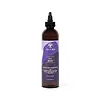What's inside
What's inside
 Key Ingredients
Key Ingredients

No key ingredients
 Benefits
Benefits

 Concerns
Concerns

 Ingredients Side-by-side
Ingredients Side-by-side

Water
Skin ConditioningSodium C14-16 Olefin Sulfonate
CleansingCocamidopropyl Betaine
CleansingCocamidopropylamine Oxide
CleansingParfum
MaskingOryza Sativa Bran Water
MaskingBrassica Campestris Seed Oil
Skin ConditioningCitrus Junos Peel Extract
Skin ConditioningPolyglyceryl-3 Diisostearate
EmulsifyingHydrolyzed Oat Protein
Skin ConditioningPolyquaternium-10
Sodium Chloride
MaskingCitric Acid
BufferingDisodium EDTA
PEG-75 Lanolin
EmollientPEG-150 Distearate
EmulsifyingPhenoxyethanol
PreservativeBenzoic Acid
MaskingEthylhexylglycerin
Skin ConditioningGlycereth-2 Cocoate
EmulsifyingPropanediol
SolventWater, Sodium C14-16 Olefin Sulfonate, Cocamidopropyl Betaine, Cocamidopropylamine Oxide, Parfum, Oryza Sativa Bran Water, Brassica Campestris Seed Oil, Citrus Junos Peel Extract, Polyglyceryl-3 Diisostearate, Hydrolyzed Oat Protein, Polyquaternium-10, Sodium Chloride, Citric Acid, Disodium EDTA, PEG-75 Lanolin, PEG-150 Distearate, Phenoxyethanol, Benzoic Acid, Ethylhexylglycerin, Glycereth-2 Cocoate, Propanediol
Water
Skin ConditioningLauramidopropyl Hydroxysultaine
CleansingBetaine
HumectantSodium Chloride
MaskingOryza Sativa Extract
AbsorbentCeramide NP
Skin ConditioningBiotin
AntiseborrhoeicPhytosterols
Skin ConditioningInositol
HumectantCopper Tripeptide-1
Skin ConditioningSerenoa Serrulata Fruit Extract
Skin ConditioningSodium Salicylate
PreservativePolyquaternium-10
Citric Acid
BufferingEthylhexylglycerin
Skin Conditioning1,2-Hexanediol
Skin ConditioningPotassium Sorbate
PreservativeSodium Benzoate
MaskingWater, Lauramidopropyl Hydroxysultaine, Betaine, Sodium Chloride, Oryza Sativa Extract, Ceramide NP, Biotin, Phytosterols, Inositol, Copper Tripeptide-1, Serenoa Serrulata Fruit Extract, Sodium Salicylate, Polyquaternium-10, Citric Acid, Ethylhexylglycerin, 1,2-Hexanediol, Potassium Sorbate, Sodium Benzoate
 Reviews
Reviews

Alternatives
Ingredients Explained
These ingredients are found in both products.
Ingredients higher up in an ingredient list are typically present in a larger amount.
Citric Acid is an alpha hydroxy acid (AHA) naturally found in citrus fruits like oranges, lemons, and limes.
Like other AHAs, citric acid can exfoliate skin by breaking down the bonds that hold dead skin cells together. This helps reveal smoother and brighter skin underneath.
However, this exfoliating effect only happens at high concentrations (20%) which can be hard to find in cosmetic products.
Due to this, citric acid is usually included in small amounts as a pH adjuster. This helps keep products slightly more acidic and compatible with skin's natural pH.
In skincare formulas, citric acid can:
While it can provide some skin benefits, research shows lactic acid and glycolic acid are generally more effective and less irritating exfoliants.
Most citric acid used in skincare today is made by fermenting sugars (usually from molasses). This synthetic version is identical to the natural citrus form but easier to stabilize and use in formulations.
Read more about some other popular AHA's here:
Learn more about Citric AcidEthylhexylglycerin (we can't pronounce this either) is commonly used as a preservative and skin softener. It is derived from glyceryl.
You might see Ethylhexylglycerin often paired with other preservatives such as phenoxyethanol. Ethylhexylglycerin has been found to increase the effectiveness of these other preservatives.
Polyquaternium-10 is an ammonium salt of hydroxyethylcellulose. It is a white and granular powder used as a film-former and anti-static agent.
This ingredient is commonly found in hair conditioning products. According to a manufacturer, its positive charge makes it great for absorbing hair proteins. The manufacturer also states this ingredient helps with curl retention.
For haircare friends: this ingredient is not a silicone.
Learn more about Polyquaternium-10Chances are, you eat sodium chloride every day. Sodium Chloride is also known as table salt.
This ingredient has many purposes in skincare: thickener, emulsifier, and exfoliator.
You'll most likely find this ingredient in cleansers where it is used to create a gel-like texture. As an emulsifier, it also prevents ingredients from separating.
There is much debate on whether this ingredient is comedogenic. The short answer - comedogenic ratings don't tell the whole story. Learn more about comegodenic ratings here.
The concensus about this ingredient causing acne seems to be divided. Research is needed to understand if this ingredient does cause acne.
Scrubs may use salt as the primary exfoliating ingredient.
Learn more about Sodium ChlorideWater. It's the most common cosmetic ingredient of all. You'll usually see it at the top of ingredient lists, meaning that it makes up the largest part of the product.
So why is it so popular? Water most often acts as a solvent - this means that it helps dissolve other ingredients into the formulation.
You'll also recognize water as that liquid we all need to stay alive. If you see this, drink a glass of water. Stay hydrated!
Learn more about Water